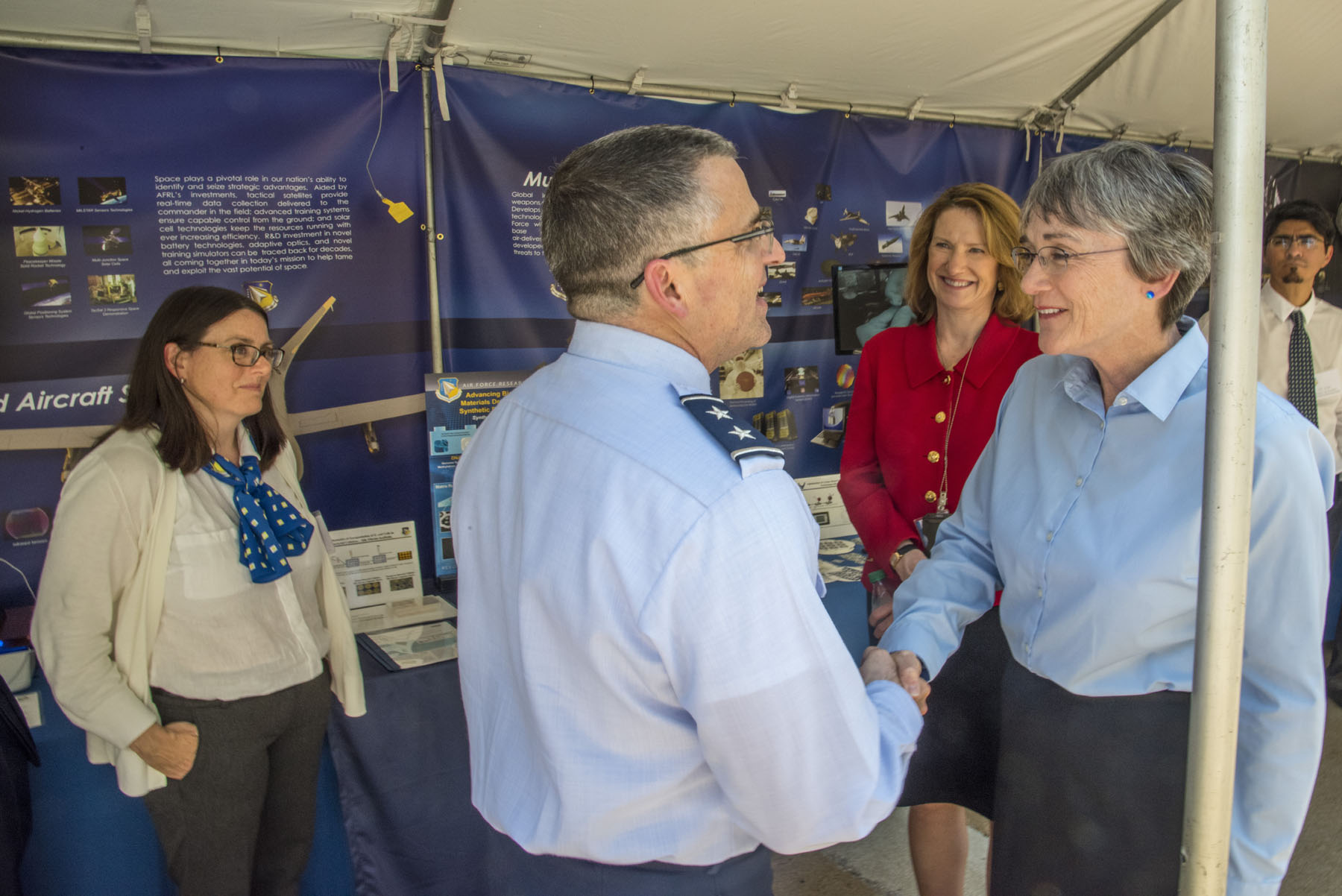
Maj. Gen. William Cooley, commander of the Air Force Research Laboratory, welcomes Secretary of the Air Force Heather Wilson to the Air Force exhibit area during the second biennial DOD Lab Day at the Pentagon on May 18, 2017. Air Force photo by Mikee Huber.
The Air Force Research Laboratory will use a yearlong 2018 review of USAF science and technology efforts to identify specific areas where AFRL needs to evolve to better meet the nation’s long-term military S&T needs.
The lab in some ways retains a “20th Century lab construct,” said Maj. Gen. William Cooley, AFRL commander, during an interview with Air Force Magazine at Wright Patterson AFB, Ohio. It needs to enhance its 21st-Century work.
“What is that?” he asked during the interview. “That’s part of the study,” he said, referencing the year-long review ordered by Air Force Secretary Heather Wilson, announced in September at AFA’s Air, Space & Cyber conference. (See also: A Hard Look at Science and Technology from the November digital issue of Air Force Magazine.)
The lab already conducts a “technology scan” every few years, to help avoid technological surprise and understand new developments. Some of AFRL’s challenges are readily apparent, he noted. For example, the speed with which new technologies are developed and the way they are transitioned out of the S&T world into operational use are “enduring problems,” Cooley said. The lab wants to develop new technologies faster and get them into the field more reliably, for obvious reasons.
In some cases the lab needs to shift from a hardware-centric to a software-centric approach in developing new capabilities. AFRL may be able to learn a lot from successful tech companies about how to be product oriented, how to develop upgrades for existing systems, and how to fail quickly and move on.
The lab’s autonomy efforts are an example of work with the 21st-Century approach. “Autonomy is in a lot of things. In the way we do deep learning,” and in scanning through thousands of images—presenting the most promising ones to intelligence analysts. “Autonomy is flying UAVs, autonomy is in satellites so that the operators don’t have to give every single command.”
Cooley said AFRL wants to become “that 21st Century lab that allows us to do autonomy right, and quickly.”
AFRL won’t go abandon its existing strengths, however. There will still be a need for large-scale hardware development. Technologies such as directed energy/laser weapons, next-generation turbine engines, and hypersonic aircraft and weapons will continue to benefit from AFRL’s traditional, large-scale research and development infrastructure.
Overall, AFRL is staffed by outstanding scientists and engineers with “a lot going very well,” Cooley said, but the lab cannot afford to rest on its laurels.
“Everything that Secretary Wilson has asked us to go do envelops the challenge I have just described,” he said. “Organizations can sometimes get in a rut and not necessarily pay attention to emerging things. Every so often you need to view with new eyes the state of the environment.”
Wilson “has asked us to do exactly that, … sort of a ‘clean the whiteboard,’ start from scratch look,” at the entire enterprise, Cooley said.
The review will run the duration of 2018, he said, with a first meeting planned for Jan. 18 hosted by the National Academy of Science’s Air Force Studies Board in Washington, D.C. Other monthly meetings will include visits with universities, industry, and private tech companies that don’t have strong relationships with the Air Force. The goal is for AFRL to establish a relationship with the potential partners, not simply have a one-off meeting.
Cooley said AFRL’s guidance is, “Do not presuppose any particular technologies, do not lead the academics or the workshops into a particular solution set, but rather leave it wide open so that we will articulate the challenges that we have in the Air Force both today and in future, … and ask them to help us think through, ‘what are some of the technologies that might help us in overcoming those challenges?”
Cooley said the Air Force Secretary will decide when and how to release the study results, but AFRL intends to provide draft results by September 2018—one year after the study was announced.